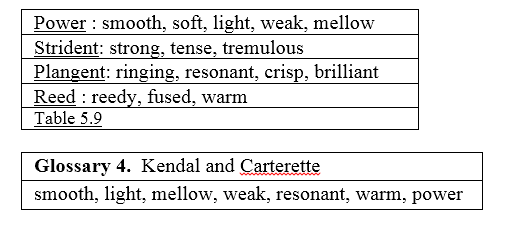The effective stiffness of a given hammer depends on the impact velocity with which the hammer hits the string, with a greater effective stiffness for higher impact velocities and visa versa. As a consequence, hitting a piano key harder will not only increase the amplitude of the string oscillation(louder tone) but shorten the contact time and thus automatically increase the proportion of upper harmonics(brighter timbre)289
Spectral Distribution
We know that the in harmonic sounds at the onset of the note are important in the identification of instrumental timbre, particularly of the piano.290 We also know that more upper partials in sound, produces a ‘brighter’ ‘sharper’ tone, and that increased loudness also produces a ‘brighter’ timbre291
a tonal impression is brighter, and possibly sharper, as richness in overtones increases (in view of the frequency range and the intensity of the upper frequency components) (von Bismarck, 1974). For low tones, rich in overtones, the dense partial sequence in the upper frequency region leads to a rough character. In contrast, overtone- poor sounds have a tendency for dark or soft timbre.292
Broad denominations ranging from dull or stuffy (few upper hamrmonics), to nasal (mainly odd harmonics) to bright or sharp (many enhanced upper harmonics)293
Kendal and Carterette’s study294 found that the use of opposite differentials, i.e. ‘bright – dark’, produced inclusive evaluations, because there is more than one opposite for ‘bright’: ‘dull’ for example. The sound stimuli used in the study were the most dissimilar sounds found in the orchestral wind family, with a descriptor range of 69 adjectives. After hearing the sounds through twice, the professional musicians chose 21 adjectives that most suited the stimuli.

Single adjective scales were used in the method described as Verbal Attribute Magnitude Estimation (VAME). The results were summarised into four groups of dimensions, into which the above attribute were grouped.

289 16Roederer,124.
290 3Fletcher& Rossing ,394 .and 7Campbell& Greated,160. and Blackham & Fletcher, 27.
291 10 Meyer,30-35.
292 11Meyer,30-35.
293 17Roederer,156.
294 RogerKendall, and Carterette,Edward. “Verbal attributes of simultaneous wind instrument timbres: I. von
Bismarck’s adjectives.”Music Perception, 10(4):445–468, 1993. Source: 5 Brent ,13.




